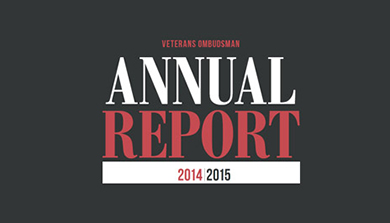The One Veteran theme, established upon my arrival, applies today more than ever as we anxiously await the implementation of improvements to the New Veterans Charter. The simple theme emphasizes the point that those who sustain similar illnesses or injuries while serving their country should have access to the same benefits, regardless of the nature of their service or of where and when they served.
...A Matter of Fairness
Table of Contents
- Letter to the Minister of Veterans Affairs
- Veterans Bill of Rights
- Introduction
- About the Office of the Veterans Ombudsman Frontline Contacts to the
- The Year in Review
- Success Through Teamwork
- Success Stories
- Listening to Veterans and Their Families
- Engaging the Influencers
- What Comes Next
- Annex A - OVO Financial Statements
- Footnotes
Letter to the Minister of Veterans Affairs
The Honourable Kent Hehr, P.C., M.P.
Minister of Veterans Affairs
House of Commons
Ottawa, Ontario
K1A 0A6
Dear Minister:
I am pleased to submit to you my Annual Report for the period of April 1, 2014 to March 31, 2015 for tabling in Parliament at the earliest opportunity.
The Annual Report summarizes the operations and key activities of the Office of the Veterans Ombudsman in the last fiscal year and highlights intended areas of follow-up for 2015-2016.
Yours sincerely,
Guy Parent
Veterans Ombudsman
Veterans Bill of Rights
The Veterans Bill of Rights applies to all clients of Veterans Affairs. They include:
- Veterans with war service
- Veterans and serving members of the CAF (Regular and Reserve)
- Members and former members of the RCMP
- Spouses, common-law partners, survivors and primary caregivers
- Other eligible dependants and family members
- Other eligible clients
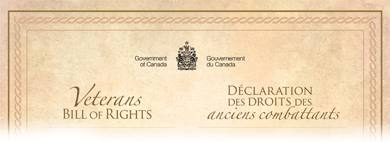
Veterans Bill of Rights
PDF
You have the right to:
- Be treated with respect, dignity, fairness and courtesy.
- Take part in discussions that involve you and your family.
- Have someone with you for support when you deal with Veterans Affairs.
- Receive clear, easy-to-understand information about our programs and services, in English or French, as set out in the Official Languages Act.
- Have your privacy protected as set out in the Privacy Act.
- Receive benefits and services as set out in our published service standards and to know your appeal rights.
You have the right to make a complaint and have the matter looked into if you feel that any of your rights have not been upheld.
The Right Honourable Stephen Harper, P.C., M.P.
Prime Minister of Canada
The Honourable Greg Thompson, P.C., M.P.
Introduction
The past year saw more progress on Veterans' issues than in all the previous years of my mandate. This underlined the importance of preparing the ground well in advance of future action. The preparatory evidence-based work that was done by my Office prior to 2014 helped to focus the discussion on key areas of the New Veterans Charter (NVC) that needed to be addressed. When I reflect on what has been accomplished both through our efforts and in collaboration with Veterans' organizations and advocates in 2014-2015, I am encouraged that movement has begun to improve the NVC to ensure the fair treatment of Canada's Veterans and their families.
A Turning Point
In June 2014, the House of Commons Standing Committee on Veterans Affairs (ACVA) released its Report, The New Veterans Charter: Moving Forward. For the first time in recent memory, a report was unanimously supported and approved by all ACVA members, laying the foundation for the Government to address the deficiencies in Veterans' benefits and services for all who have become ill or been injured through their service to Canada. Importantly, the Report closely reflected the priorities put forward by my Office and Veterans' organizations from across the country. It marked a real turning point in the long journey towards fixing the NVC.
Eager to see changes implemented quickly for Veterans, my Office continued to help influence meaningful improvements to the NVC. During this time, we continued our regular work of helping Veterans and their family members who contact our Office needing support; we actively engaged Veterans Affairs Canada (VAC) to resolve individual cases; and we pursued systemic issues affecting the well-being of many Veterans. Rounding out our ongoing activities was the publication of one Review and two Reports, outreach to Veterans and their families across Canada, op-eds, blog postings ― including a myth busting series and comparative benefit charts ― and active social media engagement.
The Winds of Change
The Government responded to ACVA's Report in the fall of 2014, agreeing with "the spirit and intent" of the majority of its recommendations. By January 2015, the winds of change had started to sweep through VAC and I saw the beginning of an alignment of issues forming between my Office, the new Deputy Minister and the new Minister of Veterans Affairs. It was based on the Veteran-centric approach originated by my Office and taken up by both the new Minister and Deputy Minister of Veterans Affairs. Announcements on implementation plans for the ACVA recommendations in the late winter and early spring of 2015 began to drive change forward. Although I have yet to see the policies and full implementation details of the resulting new benefits, they are the most tangible changes that we have seen in some time, and that gives me hope. My team and I are monitoring progress on the new benefits to make sure that they achieve the intended effect and are implemented quickly, in a manner that is fair in terms of adequacy, sufficiency and accessibility for Veterans and their families.
"Before joining the OVO nearly six years ago, I had worked at Veterans Affairs for a few years after serving in the military for more than 20 years, as have all the men in my family. Transitioning from serving to helping those who served seemed to me like the right and logical thing to do."

About the Office of the Veterans Ombudsman
What is an Ombudsman?
The Swedish word "ombudsman" means "representative of the people."
There are almost 700,000 Veterans in Canada and more than 100,000 still-serving members of the Canadian Armed Forces (CAF) and the Royal Canadian Mounted Police (RCMP) who one day will join their ranks. Whether or not they receive benefits and services from VAC, I consider all of them and their families to be stakeholders and potential clients of the Office of the Veterans Ombudsman (OVO).
"Much of our work is about digging, communicating and researching. The biggest hurdle I had to overcome was taking that initial call and feeling the pressure that I had to give the right answer – that a Veteran's well-being was depending on it. Now I know that I can look up the program, if need be, or ask questions, find the answer and later get back to the person."
How does the Office of the Veterans Ombudsman Function?
The OVO functions in accordance with the standards of practice of the International Ombudsman AssociationFootnote 1, which are endorsed by the Forum of Canadian OmbudsmanFootnote 2, namely, independence, impartiality and neutrality, confidentiality, and informality. These standards govern the way in which my Office receives complaints, works to resolve issues, and makes objective and evidence-based recommendations that I provide to the Minister of Veterans Affairs and VAC.
As an arm's length organization, the OVO acts as an independent voice for those served by VAC. As such, we provide direct services to a widely-dispersed client base to ensure that the needs of Canada's Veterans and their families are considered. Additionally, my role as a Special Advisor to the Minister of Veterans Affairs offers me the opportunity to present, directly to the Minister, matters of importance to the Veterans' community.
The One Veteran theme guides how issues are viewed in my Office. As I have said before and I will continue to say, those with similar illnesses or injuries should have access to the same benefits, regardless of the nature of their service or when and where they served.
At the OVO , we view fairness as an outcome that can be objectively measured in terms of the adequacy, sufficiency and accessibility of the benefits and services to address the needs of ill and injured Veterans and those still in uniform.
What is the mandate of the Veterans Ombudsman?
The Order in Council P.C. 2007-530Footnote 3 gives me the mandate to:
- review and address complaints by clients and their representatives arising from the application of the provisions of the Veterans Bill of Rights;
- identify and review emerging and systemic issues related to programs and services provided or administered by the Department or by third parties on the Department's behalf that impact negatively on clients;
- review and address complaints by clients and their representatives related to programs and services provided or administered by the Department or by third parties on the Department's behalf, including individual decisions related to the programs and services for which there is no right of appeal to the [Veterans Review and Appeal] Board;
- review systemic issues related to the [Veterans Review and Appeal] Board, and
- facilitate access by clients to programs and services by providing them with information and referrals.
What is our Vision?
At the OVO, we aspire to be recognized as a centre of excellence in the use of ombudsman best practices that advance the fair treatment of Veterans and their families.
What is our Mission?
Our mission is to ensure the fair treatment of Veterans and their families and to uphold the Veterans Bill of Rights by reviewing and addressing complaints, emerging and systemic issues regarding the programs, benefits and services provided by VAC.
Who Do We Serve?
My team stands ready to assist members of the Veterans' community, serving members of the CAF and the RCMP, as well as other clients of VAC:
- Veterans of the Second World War and the Korean War;
- Veterans of the CAF (Regular Force and Reserve Force);
- Serving members of the CAF (Regular Force and Reserve Force);
- Veterans of the RCMP;
- Serving members of the RCMP;
- Immediate family members and caregivers of any of the above-mentioned groups, and
- Survivors of Veterans.
What Services Do We Provide?
These are the four main services provided by the OVO:
Information: Frequently, those who call the OVO are unaware of the benefits, services, and redress mechanisms available to them. Our Office helps them navigate the complexity of the system by providing information about their rights and about the benefits and services provided by VAC and other organizations.
Referrals: The OVO assists those who call for help, often as a last resort, by facilitating referrals to service providers that can best assist them.
Complaint resolution: The OVO addresses complaints from individuals who believe they have been treated unfairly by VAC or other service providers. To bring closure as quickly as possible, every attempt is made to resolve complaints informally and at the lowest level possible, most often through inquiries and informal mediation with the Department. For example, procedural issues are discussed informally with the Department to bring resolution as quickly as possible. A telephone call or an exchange of correspondence is often all that is needed to bring about change.
Interventions to address systemic issues: When the facts of a case raise systemic issues that can potentially affect many other Veterans and clients of VAC, when there are multiple complaints about the same issue, or when issues emerge as a result of the Office's interaction with the Department and the Veterans' community, my team will intervene using various approaches based on the nature and complexity of the issue.
The OVO undertakes reviews to highlight the information available on a particular topic, as well as the various points of view. Review papers, which do not contain recommendations, are produced for the purpose of facilitating informed discussion on issues of concern to the Veterans' community. Reports are created most often to address complex issues. These formal Reports contain recommendations supported by thorough research and analysis that are submitted to the Minister of Veterans Affairs for action. Reviews and Reports are ready for publication 60 days after submission to the Minister.
"I was a Reservist for almost 10 years […] After returning to Canada following a deployment to Afghanistan, I relocated to Petawawa, ON where I was employed with the Department of National Defence as a civilian in the environmental field. I was back in PEI working with Service Canada when I joined the OVO in December 2014. I had many friends transitioning after their deployment to Afghanistan and I wanted to try to help whichever way I could."
What Does My Team Look Like?
I am supported by a team of 35 employees ― located in Ottawa and Charlottetown ― composed of service representatives, intervention analysts, program review advisors, legal advisor, policy advisor, communicators, and administrative support staff. Among my team are former members of the CAF, as well as experienced public servants.
I also rely on an Advisory Council for advice on matters of concern to the Veterans' community, to foster cooperation among Veterans' groups and to increase dialogue between us and the many groups and organizations that care about the well-being of Veterans and their families. The Advisory Council is comprised of Veterans' representatives, professional advisors from academia, health care, rehabilitation or other fields, and affiliate members with varied areas of expertise. I invite you to read the Terms of Reference of the Veterans Ombudsman Advisory Council.

Structure of the Office Organizational Chart
- Veterans Ombudsman
- Legal Advisor
- Deputy Ombudsman & Executive Director
- Senior Policy Advisor
- Media Relations Advisor
- Corporate Services & Charlottetown Operations Directorate
- Strategic Review And Analysis Directorate
- Communications Directorate
"When a Veteran contacts the OVO and requests someone specifically because of prior dealings, this is in my opinion the ultimate demonstration of client satisfaction. I know that my colleagues and I have the knowledge and skills necessary to assist Veterans and we will always do our best. When faced with an unknown, every one of us will willingly seek help to ensure Veterans are well served and get the help they need."
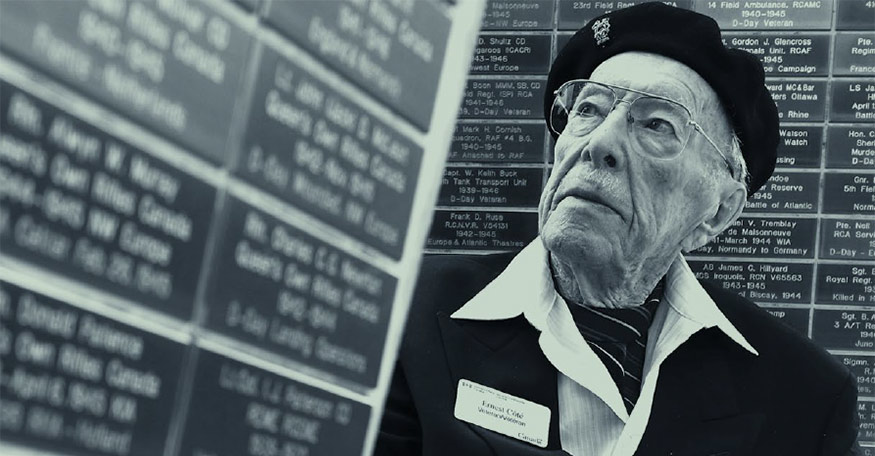
The Year in Review
Published Reports and Reviews
The OVO began the year with the publication of the third Review of a series on Veterans health care, entitled Veterans' Long-Term Care Needs: A Review of Assisted Living Options for Veterans. I believe that this Review is an excellent resource to anyone looking to secure care for their senior years and to care for a loved one that requires assistance with activities of daily living.
By mid-summer, the OVO had also published the fourth Report of the NVC series: Supporting Severely Impaired Veterans: A Report on the New Veterans Charter Permanent Impairment Allowance and Permanent Impairment Allowance Supplement. This allowance was created to compensate for loss of earning capacity, specifically for the effects of a permanent and severe impairment on a Veteran's employment and career progression opportunities. Unfortunately, our findings show that accessing these benefits is not only difficult, but those who are able to access them most often are assigned the lowest grade level. The Report included four recommendations addressing these shortcomings in keeping with the intent of the allowance.
The final Report published towards year-end was Veterans Right to Fair Adjudication: The Follow-Up Report. This Report is an evaluation of the implementation of the seven recommendations put forth to the Veterans Review and Appeal Board (VRAB), VAC and the Minister of Veterans Affairs in 2012 in order to improve the adjudication of Veterans benefits.
"Having someone in real need at the other end of the phone and knowing that because of policy limitation, you are unable to help is one of the toughest things about my job. Not having the power to do something for them can be very frustrating."
Research and Analysis on Transition to Civilian Life
In August 2014, we broke new ground by working collaboratively for the first time with the Department of National Defence/Canadian Forces (CAF) Ombudsman on a Joint Transition Project. The goal of this joint effort is to identify and recommend ways to streamline administrative processes and support services to the benefit of transitioning medically-releasing members and their families. These processes need to be as seamless as possible, with clear and transparent information and communications to members. CAF Ombudsman Gary Walbourne and I are hopeful that this work will lead to improvements that reduce the struggles brought on by what can be a challenging life change.
To date, the team has completed a detailed map of the transition process from the time a permanent medical category is recommended until such time as the Regular Force member is integrated into VAC. Also, over 50 recommendations and responses related to the transition process from recent House of Commons, Senate, and Auditor General Reports have been reviewed. Furthermore, policies, regulations, business processes and procedures from both the Department of National Defence (DND) and VAC have been reviewed, and interviews with key DND/CAF and VAC stakeholders have been held to validate the preliminary findings.
Based on examination completed thus far, the team has noted several core issues pertaining to governance, program-centric service delivery and support to families that should be addressed to facilitate a seamless transition.
We will share our findings, and more, in the coming months because successful transition for a medically-releasing serviceman or woman is key to financial independence, quality of personal and family life and improved health.
Frontline Contacts to the OVO
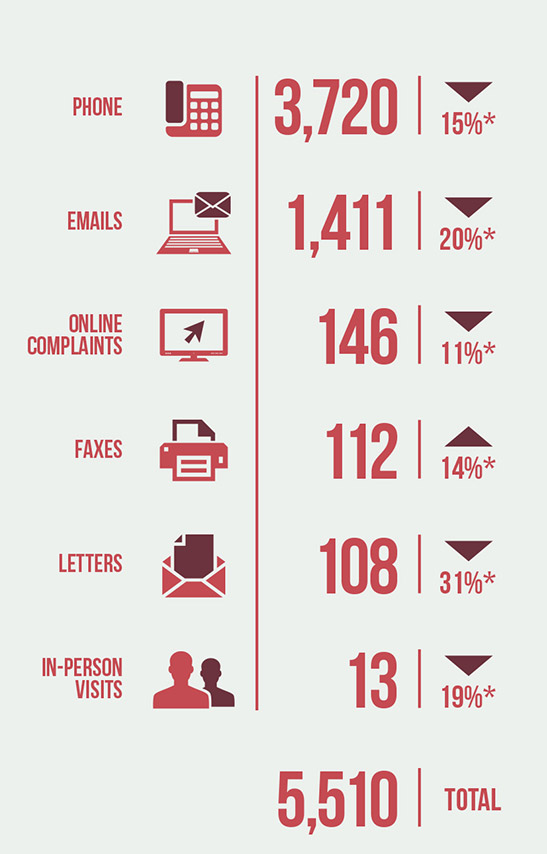
Frontline Contacts to the OVO
*Compared to previous year
Phone: 3,720 (15% decrease*)
Email: 1,411 (20% decrease*)
Online complaints: 146 (11% decrease*)
Faxes: 112 (14% increase*)
Letters: 108 (31% decrease*)
In-person visits: 13 (19% decrease*)
Total 5,510
In 2014-2015, over 5,500 contacts were made to our frontline staff. As a result, 1,628 new files were opened and added to the 121 files carried over from 2013-2014. During the year, we were able to close 1,388 files and we carried over 361 into 2015-2016. A file is opened for every information request, referral and intervention. Multiple files can be opened for a single client to address either an information request, a referral or an intervention given that a Veteran can be faced with more than one issue or condition.
Types of Services We Provided
It is important to note that the number of interventions performed in 2014-2015 represents a 17 percent increase from 2013-2014. An 11 percent decrease has been observed in information requests and referrals have also decreased by 6 percent. Given the increased number and complexity of interventions, this translated into an increased workload.
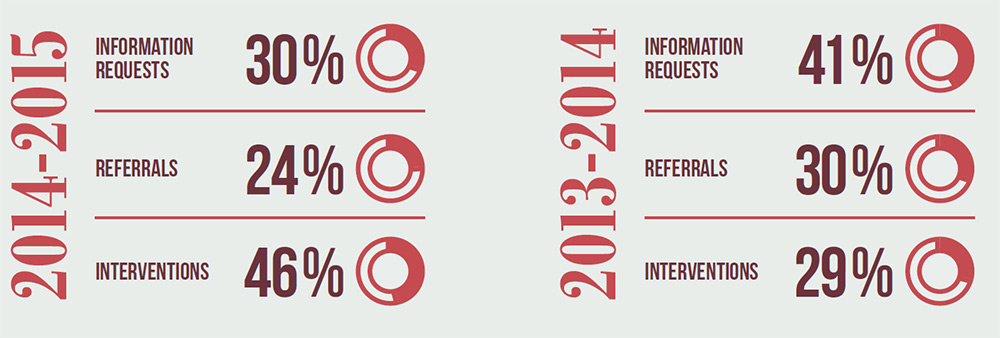
Graph - Types of Services we Provide
2014-2015
Information Requests: 30%
Referrals: 24%
Interventions: 46%
2013-2014
Information Requests: 41%
Referrals: 30%
Interventions: 29%
Types of Issues Our Clients Faced
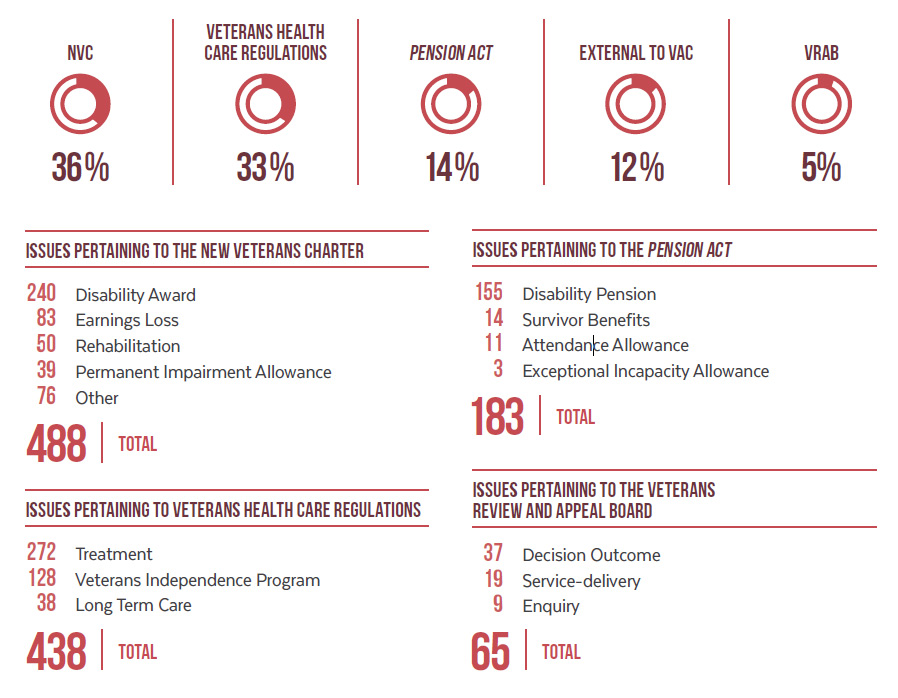
Graph - Types of Services we Provide
| NVC 36% | Veterans Health Care Regulations 33% | Pension Act 14% | External to VAC 12% | VRAB 5% |
Issues pertaining to the New Veterans Charter
Total 488:
240 Disability Award, 83 Earnings Loss, 50 Rehabilitation, 39 Permanent Impairment Allowance, 76 other.
Issues pertaining to Veterans Health Care Regulations
Total 438:
272 Treatment, 128 Veterans Independence Program and 38 Long Term Care.
Issues pertaining to the Pension Act
Total 183:
155 Disability Pension, 14 Survivor Benefits, 11 Attendance Allowance, 3 Exceptional Incapacity Allowance.
Issues pertaining to the Veterans Review and Appeal Board
Total 65:
37 Decision Outcome, 19 Service-delivery, 9 Enquiry.
Of the 12 percent of clients that were referred to another organization because their issue did not pertain to VAC, nearly half were redirected to DND in 2014-2015.
Our Clients
In 2014-2015 our largest client group was former Regular Force members (538 or 49 percent), who represent nearly half of our overall clientele. As well, it is worth noting that there have been increases in the majority of service categories, with the exception of traditional Veterans and survivors, as expected. Former Regular Force members increased by 8 percent while those still serving increased by 13 percent. Reservists also engaged us more in 2014-2015 as shown by an 18 percent increase in serving reservists and a 23 percent increase in former reservists. Finally, RCMP members, either still serving or former members, who historically rarely reached out to us, engaged us more in 2014-2015. In fact, the largest percentage increase was among serving RCMP members at 86 percent. A 13 percent increase was also noted with former RCMP members.
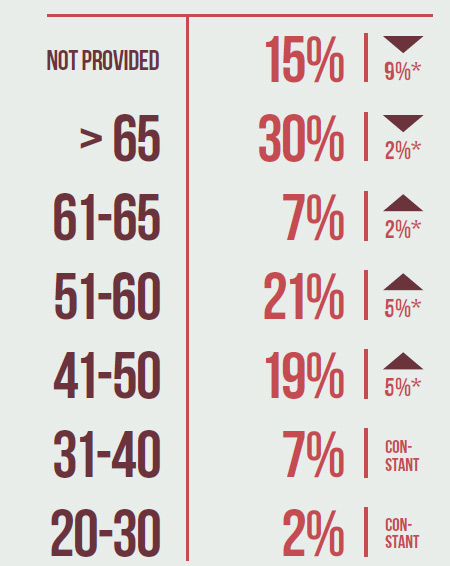
Graph - Age Group and Gender
15% age not provided down 9% from last year
> 65 = 30% (down 2% from last year)
61-65 = 7% (up 2% from last year)
51-60 = 21% (up 5% from last year)
41-50 = 19% (up 5% from last year)
31-40 = 7% (constant)
20-30 = 2% (constant)
*Compared to previous year
Just over one fifth of our clients are women (21 percent), but when looking solely at the former Regular Force category, that ratio lowers to 11 percent, which is consistent with the current female representation in the CAF.
Source of Awareness
Throughout 2014-2015, the OVO provided services to more than 1,100 clients, several of them having multiple issues, and nearly a third of them heard about us from a friend. Our website also proved to be a good source of awareness, followed closely by referrals from VAC.
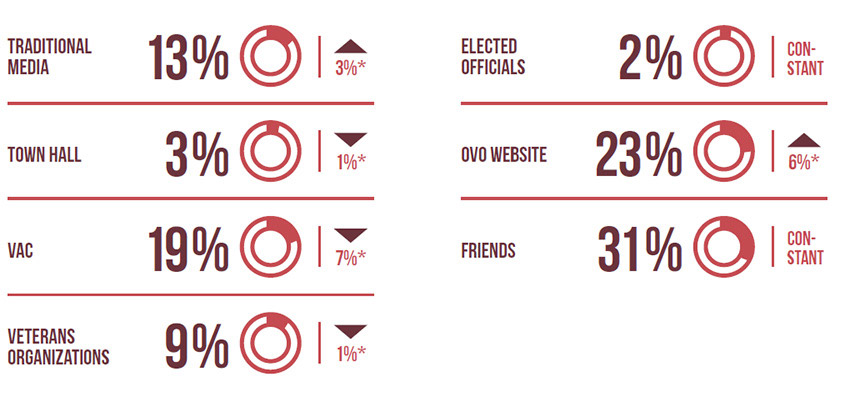
Graph - Source of Awareness
Compared to previous year *
Traditional media 13% (up 3%*), Town Halls 3% (down 1%*), VAC 19% (down 7%*), Veterans Organizations 9% (down 1%*), Elected Officials 2% (constant), OVO Website 23% (up 6%*), Friends 31% (constant)
"Having spoken to multiple VAC and Blue Cross agents this morning to no end, I finally contacted an agent with the Veterans Ombudsman's Office. The latter was the only person who provided any helpful, useful information, and she was REALLY helpful. […] She told me what actually needed to be done and she even contacted my doctor's office to give him the VAC phone number that needed to be contacted for special authorization of the prescription, and then she called me back to tell me that she had done so. Now that's service!"
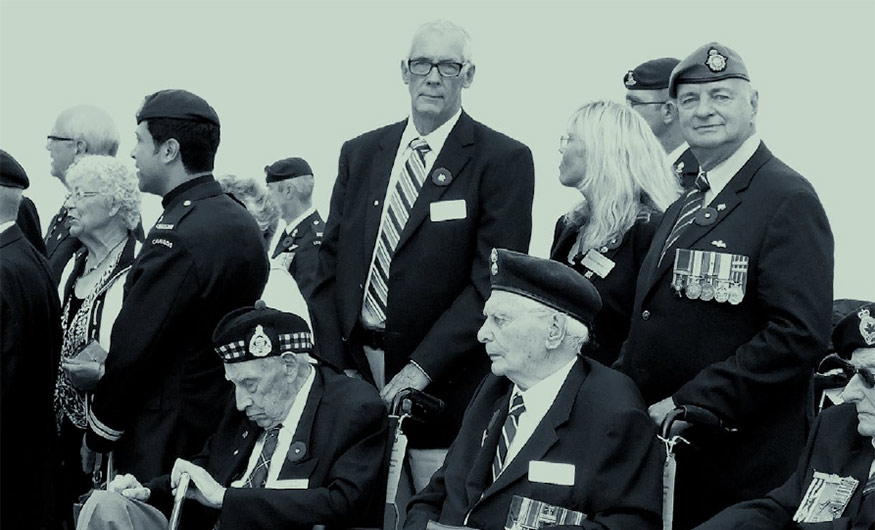
Success Through Teamwork
At times, advocating for change for Veterans and their families means engaging with VAC's decision makers to identify issues of concern and provide suggestions for change. To foster tangible change, we present evidence-based analysis to support the concerns we pick up through our interactions with Veterans and their families. We then work with the Department to find a fair and acceptable solution for all concerned parties. Throughout 2014-2015, this approach has yielded a number of notable successes, as described below.
Death During Application
Since 2009, my Office has been involved in three cases of Veterans who died while awaiting a decision on their entitlement for disability benefits. When this occurs and VAC is made aware of the Veteran's death before completing the benefit adjudication, the process stops. In the case where VAC learns of the Veteran's death after processing payment for disability benefits, the payment is recovered. It is unfair to deny a payment to a Veteran's estate, especially given that the Veteran would have received the monies in their lifetime were it not for administrative delays in processing the claim.
My team and I again raised these concerns with VAC, and I discussed the matter with the Minister, Deputy Minister and VAC's Service Delivery and Program Management Division. In August 2014, VAC implemented a new internal policy pertaining to "Red Zone" status files, which are used by VAC as a means to accelerate at-risk clients through the disability benefits process. After conducting a file review to assess the magnitude of the death during application problem, VAC found that the new policy would have ensured that 75 percent of cases of death during application raised in 2013 would have seen a decision rendered before the death of the applicant.
"Veterans are told to expect a 16-week delay before a decision is made on their disability application. Weeks later they are told that the clock didn't start on the day they applied but rather on the day the application was complete. It sometimes takes weeks for VAC to get access to medical records and Veterans need to know that to plan accordingly."
This is confirmation that improvement can be made when evidence of an unfair matter is collected and presented to those that have the authority to effect positive change. Through teamwork between VAC and my Office, we were able to ensure that applications for at-risk Veterans are processed without delay in order to ensure they receive the benefits they need and deserve. Our recommendation, however, that disability benefit payments should be made to the Veteran's estate, in the case of death, has not been addressed.
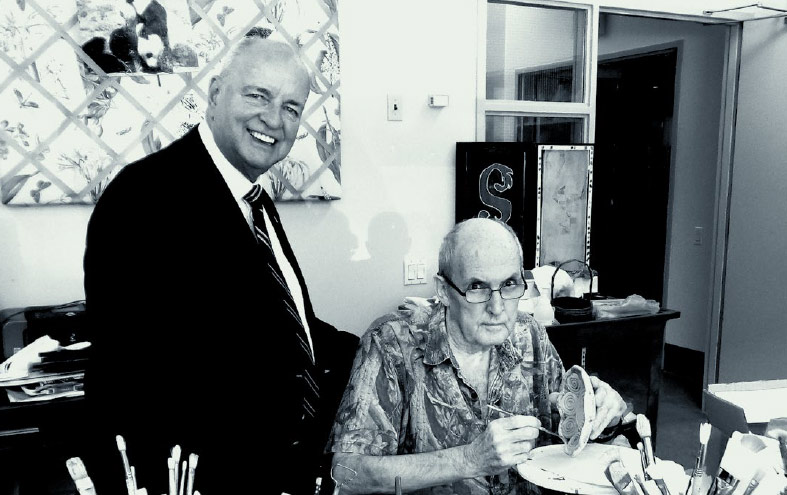
Turnaround Times and Favourability Rates
One of our roles at the OVO is to identify systemic issues that require further investigation and to work with VAC towards a resolution. In these cases, we produce Reports and Reviews, and engage VAC leadership at various levels to push for change. Such was the case with VAC's reporting of turnaround times and favourability rates. The Office has received many complaints in these areas and our case tracking analysis indicated that their numbers had been on an upward trend for the past three years.
Turnaround times for disability benefit decisions are particularly important as they dictate how quickly a Veteran receives the needed benefits and services. VAC's service standards should be reasonable, and the entire process must be clearly laid out and communicated well so that Veterans and their families have realistic expectations of how long they will have to wait for a decision to receive compensation and when they will be able to access treatment benefits and related services.
How VAC communicates favourability rates to Veterans, their families, parliamentarians and the Canadian public has also raised concerns with me for several reasons. For example, a VAC docket is deemed favourable even if only one of several conditions for which a Veteran claims disability benefits is approved. This can be misleading and result in a high rate of favourable decisions when in actual fact, benefits may be denied much more frequently than reported. Because VAC uses this information to show that Veterans are receiving timely decisions and are being recognized for their service-related disabilities, there must be a clear understanding of how these rates are calculated and the results must be openly communicated to avoid creating false expectations.
When I presented to VAC's leadership the results of the OVO's evidence-based findings in this area, it was agreed that favourability rates should indeed be reported by condition and by docket. It was also agreed that performance standards for turnaround times will be communicated clearly in the future to Veterans. I look forward to the implementation of these changes and will report back to the Veterans' community on them.
Veterans Ombudsman Commendation
I take great pride in having the opportunity to recognize the many individuals and groups who work tirelessly on behalf of Veterans and their families. Therefore, I was delighted to see that during the nomination period for the 2014 Veterans Ombudsman Commendation, we received more nominations than ever before.
Reviewing and assessing all of these submissions was no easy task, and I thank the members of our Advisory Council for their assistance with the selection process. Every year, through this process, I learn about the many exceptional contributions being made by members of the Veterans' community that too often go unrecognized.
In November 2014, I was honoured to present the Veterans Ombudsman's Commendation to Dr. Heather MacKinnon and Mr. Thomas Lewis Hoban. Dr. MacKinnon received the Commendation for her tireless work with federal and provincial governments in improving healthcare programs to better serve the needs of Veterans and their families. Mr. Hoban, a retired RCMP and active member of the community, received the award for his years of advocating for troubled youth, aboriginal Veterans, and homeless Veterans to ensure that those who proudly served maintain an acceptable standard of living.
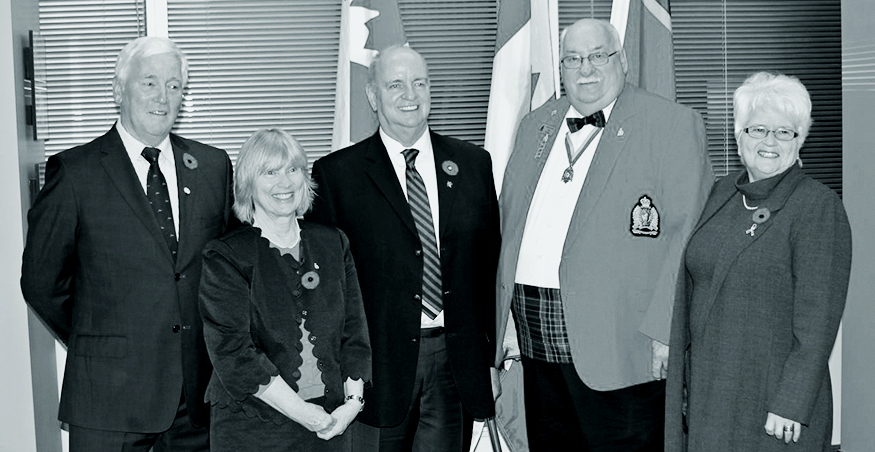
True Patriot Love's November 2014 Multinational Symposium focused on improving the support to our military families. The OVO is invested in ensuring that the needs of the families of our Veterans and serving members are addressed. I was pleased to have participated and to have had the opportunity to exchange ideas with delegates from around the globe.
"Working at the OVO has ups and downs as far as pleasure and stress. When at the end of the day, I know that thanks to what we do, a Veteran in need will be cared for properly, I know that what we do at the OVO is meaningful."

Success Stories
A Simple Referral Makes a Real Difference
"Recently a Veteran called with a housing situation; he lived in a high crime-rate area and he no longer felt safe living there. I was able to put him in touch with someone at VETS Canada (Veterans Emergency Transition Services) and they had someone come out and work on getting him some help to relocate to a safer place."
"I founded VETS Canada in 2010-2011 because as a Veteran, I wanted to give back to my community when I realized that too many of my fellow Veterans were not making successful transitions to civilian life. Instead, some were slipping through the cracks, becoming homeless and at-risk living on the streets. From my first small team in Halifax that went to seek and help fellow Veterans reintegrate into civilian life, today VETS Canada operates across the country… and the need goes on. We just did what needed to be done."
"Thank you for reaching out to me via phone call today. Your support is important to me. […] I am understanding more and more the importance of expressing my situation. […] Thank you for your ear. For your voice."
Getting Involved Enough to Pinpoint the Problem
"I was on a call that was going OK when the Veteran broke down and suddenly hung up. I was concerned for his well-being so I called him back and that is when I found out he had a small disability award for a back injury. I asked him about his treatment only to find out that he had none currently in place. This young Veteran was out of work and at the end of his rope. We had a long conversation. I explained to him the coverage he was entitled to and encouraged him to apply for the rehabilitation program knowing that this would not only offer him the opportunity to learn new skills for future employment, but it would also give him access to health care management and counselling for any mental health related issues."
Being Prepared to Help Is Key
"Recently I had a very difficult conversation with a Veteran who expressed his distress to me and spoke about his suicidal tendencies. Such calls are extremely emotional and must be handled very delicately. Thankfully, because the frontline staff at the OVO completed a suicide intervention course, I was better equipped to intervene. The training we received made it easier for me to talk with this particular caller. Being able to reach out and help, even a little, is very gratifying."
"The best thing is being able to provide assistance to a Veteran in need. We can't always help unfortunately but it is great to know that you impacted someone's life positively when you can. I spoke with an individual one day who said to me: "I have been dealing with VAC for six years and I learned more talking to you today than during this whole period." That's the kind of feedback that makes you want to work even harder. […] People get straight answers from us and that is what makes a real difference in a lot of cases."
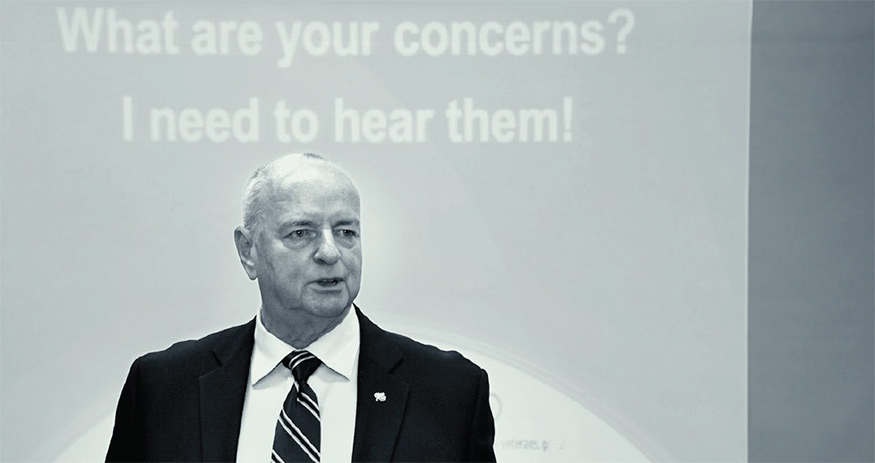
"I see continued learning and exchanging of ideas with like-minded organizations as a way to stay on the cutting edge in the service we provide to our clients. In June 2014, the Forum of Canadian Ombudsman (FCO) brought many of us together to do just that at their Annual Conference and General Meeting. Then in September 2014, I was part of a panel of Ombudsmen, on a week-long course entitled the Essentials for Ombuds, offered by the FCO and York University's Osgoode Hall Law School. This allowed me to share the successes and challenges of the OVO and gave me the opportunity to learn from other leaders in the field."
Listening to Veterans and Their Families
I value and use every opportunity to meet with Veterans, their families, and those who care for them or advocate for their well-being. It is essential for me to hear their concerns in order to ensure that we prioritize our work and address what resonates the most within the Veterans' community.
As I plan my outreach across the country each year, I do my best to visit new locations to meet with local Veterans. I do this as much as possible so that I can hear directly from Veterans and their families, in their own voices, their challenges and concerns. My visits and town hall sessions allow me to do just that. I also never pass up the opportunity to inform Veterans that I meet about the benefits and services available to them and of the work that we do at the OVO.
Outreach
This year, given the volume of activities that took place in the spring and summer months, my outreach began in the fall with visits to Kelowna and Penticton, British-Columbia, where I met with Veterans and their families. This trip also offered me the opportunity to take part in ANAVETS' 52nd Biennial Dominion Convention where I spoke about long-term care and the shortcomings of the NVC.
I consider working with Veterans' organizations and advocates to be a vital part of what I do; to work towards improving conditions for Veterans and their families. It is also important that we know what each other is doing because in my experience, if we are working towards a common goal, we are listened to more seriously and change is more likely to occur.
My next stops were Halifax, Nova Scotia, followed by Quebec City, Valcartier and Saguenay―Lac-Saint-Jean, Quebec, in the early winter of 2015. I concluded my annual outreach program in March with visits to Barrie, Borden and the Greater Toronto Area, Ontario.
"I completed a variety of courses as part of my integration, to learn about the military service and its rank structure for example. It is reassuring to know that I, and ultimately Veterans, can benefit from the teamwork and knowledge sharing that exist and are strongly encouraged at the OVO; the continuous learning environment is refreshing!"
Staff from our frontline always accompany me during my outreach activities. My team is available to speak one-on-one with clients about their personal cases, and the concerns they share do not go unheard. After each session, the team and I compile all of the feedback we received in order to look into potential areas of concern, and we work with our new clients to assist them as best we can with their individual cases.
During outreach activities, we were fortunate enough to meet with many Veterans, serving members, families, municipal leaders, and service providers in each of the areas we visited. I was particularly encouraged to see an increase in participation at my public town hall sessions by modern-day Veterans and their spouses. We strive to reach all demographics, and it was a pleasure to be able to hear about their particular challenges and offer our assistance to those who were not previously aware that the OVO was there to assist them too.
While meeting with Veterans is always the primary goal of my travels, another important aspect is meeting with those who serve our Veterans. In each outreach location, I try to visit the local VAC offices to discuss the work of our respective offices and hear their questions and concerns. It's crucial for me to also hear from VAC staff as they are often a Veteran's first point of contact and are in an opportune position to report on what's working, what's not, and how things could improve to provide better service to our Veterans and their families. Comments and concerns may vary slightly from region to region, but one common sentiment seems to connect staff regardless of their work location: the desire to provide excellent service to a growing number of clients with varying needs, despite limited resources and decision-making authorities. Their feedback is something my team and I value and share with VAC decision-makers.
I am also always impressed by the dedication of the staff we meet at Joint Personnel Support Units (JPSUs) during our outreach visits. We are able to hear the unique perspective of staff who provide assistance to ill and injured serving members who are recovering or transitioning to civilian life. These meetings provide clarity and first-hand insights into the current transition process, the struggles faced by those going through it, and potential areas for improvement.
"I would like to thank you for taking the time to visit with Veterans in Barrie yesterday (March 11, 2015). Your presentation was informative, but your genuine concern to support Veterans and their families was/is much more [appreciated]."
Meaningful Recognition
History was made on September 4, 2014 when the 28 NATO Heads of State and Government signed a Declaration that clearly states their support to their serving Armed Forces members, their Veterans, and their families. This significant gesture opened the door to a more robust and dynamic information exchange on best practices and lessons learned amongst NATO member states. It also reinforced the pride I feel for our country for being one of only a few countries with an entire federal department dedicated to supporting Veterans and their families and the only country with a Veterans Ombudsman and a Veterans Bill of Rights.
International Commemoration
While most of my work is focused on ensuring that Veterans and their families receive the support they require and deserve, I also take every opportunity that I can to recognize and commemorate the sacrifices of our service men and women who have gone before us. I value the opportunity to come together with Veterans to remember and reflect on their invaluable contributions to the peace and freedom we enjoy today.
In April 2014, I had the privilege of travelling to France to commemorate the 97th Anniversary of the Battle of Vimy Ridge. I returned to France in early June to commemorate the 70th anniversary of D-Day and the Battle of Normandy. It was truly humbling to stand where brave Canadians stood so many years ago and salute their immense sacrifices.
It was a source of pride for me later in November 2014 to be part of the Canadian delegation to commemorate the 70th anniversary of the Italian Campaign at events and ceremonies in Italy. It was an unforgettable opportunity to honour the nearly 6,000 Canadians who sacrificed their lives to help liberate Italy in the Second World War.
Commemorating Veterans and their families is an important aspect of the role of the Veterans Ombudsman. I have the honour of recognizing their sacrifices at ceremonies and events throughout the year, at home and abroad. In 2014, some of the commemorative events that I took part in include:>
- Commemorative Ceremony of the 97th Anniversary of the Battle of Vimy Ridge, France - April 9, 2014.
- National Day of Honour – Ottawa, Ontario – May 9, 2014
- Guest Speaker at the Champ D'Honneur Ceremony – Montreal, Quebec – June 1, 2014
- 70th Anniversary of D-Day and the Battle of Normandy – France – June 3-9, 2014
- Aboriginal Veterans Autochtones Annual Ceremony of Remembrance – Ottawa, Ontario – June 20, 2014
- Merchant Navy Veterans Day of Remembrance Ceremony, 75th Anniversary – Ottawa, Ontario – September 7, 2014
- National Remembrance Day Ceremony – National War Memorial, Ottawa, Ontario – November 11, 2014
- 70th Anniversary of the Italian Campaign – Italy – November 22-30, 2014
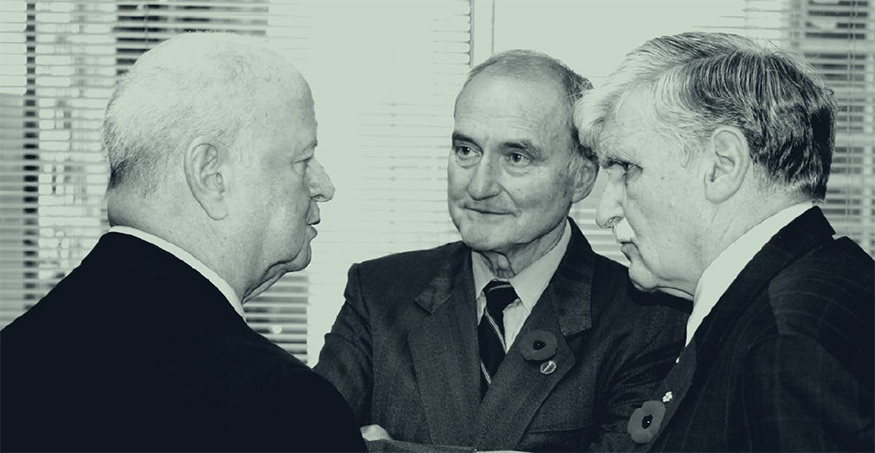
"Please pass on my very sincere congratulations and thanks to the Ombudsman for his outstanding blogs on myth busting the NVC. The work is very impressive in its clarity and understandability. It will serve well to address and overcome the problems which exist in communicating information about the NVC."
Engaging the Influencers
Since the beginning of my mandate in 2010, we have focused on building trust with parliamentarians and key stakeholders by providing them with objective, evidence-based analysis and recommendations on Veterans' issues.
Parliamentary Appearances
It was a privilege for me to appear before the House of Commons Standing Committee on Finance in May 2014 to speak to the need to improve financial support to ill and injured Veterans and their families under the NVC. After ACVA released its Report, I reappeared before the Finance Committee in September 2014 to emphasize the importance of funding the changes recommended in The New Veterans Charter: Moving Forward. Later in November, I joined Gary Walbourne, the CAF Ombudsman, to present to the Senate Liberal Open Caucus the findings to date on our Joint Transition Project. My final parliamentary appearance of the year was on February 18, 2015 when I shared my views on the Veterans Hiring Act – Bill C-27 with the Senate Subcommittee on Veterans Affairs.
"I would like to take a brief moment of your busy day to express my sincere gratitude for the assistance that [your office] has given me [with] my current disability applications and any questions I have asked. [PTSD] at times amplifies any stress or frustration encountered. When I felt all avenues at VAC had been exhausted, I decided to contact your office for help. From the moment [the Ombudsman Service Representative (OSR)] picked up the phone, he acted in a professional and caring manner. […] It was via [your OSR] and his investigations that I started to finally receive answers. It was not a matter of favourable or non-favourable but just simple [answers] satisfying my questions. I am very glad that your office has within it people that are willing to go that one step more to provide information for Veterans such as myself."
Outreach and Education
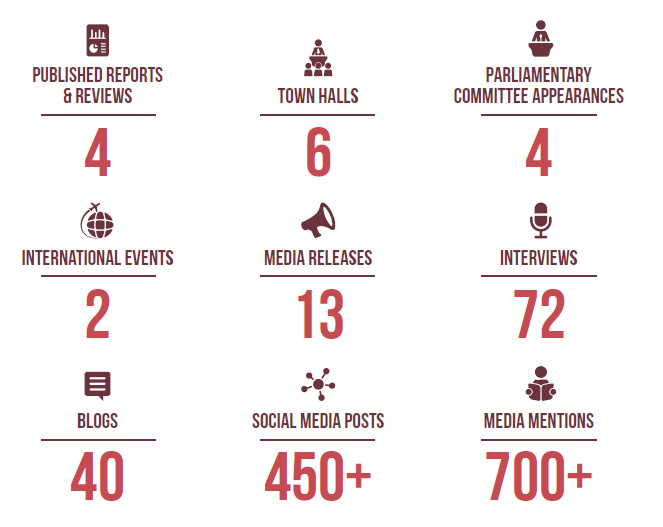
Graph - Outreach and Education
- Published Reports & Reviews: 4
- Town Halls: 6
- Parliamentary Committee Appearances: 4
- International Events: 3
- Media Releases: 13
- Interviews: 72
- Blogs: 40
- Social Media Posts: 450+
- Media articles: 700+
It is important to review not only the accomplishments of the Office but also how well we applied the principles of ombudsmanship, namely independence, impartiality, fairness, accessibility and confidentiality to our approaches."
What Comes Next
You may recall that after the Government's March 2015 announcements on improvements to the New Veterans Charter through Bills C-58 and C-59 and new benefits and services, we published a report card comparing the Government's announcements to our recommendations. The next step for my team and me is to analyze and report back to you on the new benefits and their applicable policies and regulations in order to ensure that they achieve their intended effect. At the same time, we will be updating our report card, so please stay tuned.
In 2015-2016, we will also continue to publish Reviews and Reports on issues of concern to Veterans and their families, including a follow-up Report to update Veterans and all interested parties on the implementation status of our recommendations to VAC in our 2011 and 2012 releases: Veterans' Right to Know Reasons for Decisions: A Matter of Procedural Fairness and Veterans' Right to Disclosure - A Matter of Procedural Fairness. The purpose of the original series was to identify areas of improvement related to the disability application and adjudication process.
As well, in collaboration with the RCMP, next year the OVO will be working on a review of the benefits and services provided to their members for illness or injuries attributable to service.
Research and analysis will continue in 2015-2016 on the Joint Transition Project with the CAF Ombudsman. Activities to identify gaps and duplication will include completing the detailed mapping of the transition process for all classes of Reserve Force members; mapping all three Vocational Rehabilitation Programs (CAF), Service Income Security Insurance Plan and VAC); examining the role of family members and support provided to families during transition; examining the role of third-party, non-government service providers, and conducting a qualitative research study on the determinants of successful transition.
Finally, we will be looking at how well we apply the principles of ombudsmanry to our own handling of complaints and systemic issues. There is much discussion today within the ombudsman community on the need to adapt our practices to the major socio-economic and technological challenges that we are facing, if we are to remain relevant and effective in our work. So, in 2015-2016, we will take a critical look at how we fulfill our mandate and how we can do it better.
In closing, I would like to thank the members of my team and my Advisory Council, Veterans and their families, Veterans' organizations and Veterans' advocates who worked tirelessly to achieve the goal of opening up the NVC for review. Without you, it would not have happened; with you, Veterans and their families have the chance of a better future.
Guy Parent
Veterans Ombudsman
Annex A - OVO Financial Statements
As per the 2014-2015 Report on Plans and Priorities, the Veterans Ombudsman's planned spending was $5.8 million for the same fiscal year. The actual authorities at the end of fiscal year 2014-2015 were $5.3 million.
Planned Spending and Treasury Board Authorities 2014-2015
| Organization | Salary | Operating | 2014-15 Planned | 2014-15 Authorities |
|---|---|---|---|---|
| Office of the Veterans Ombudsman | $2,797,700 | $1,169,200 | $3,966,900 | $3,966,900 |
| Veterans Affairs Canada (provision of services to the Office)* | $726,771 | $514,800 | $1,241,571 | $741,571 |
| Treasury Board (employee benefits) | $581,538 | $600,609 | ||
| Net Adjustments (incl. Collective Bargaining) | $2,931 | |||
| Total | $5,790,009 | $5,312,011 |
* 2014-2015 Authorities reflect a transfer of $500,000 from the Veterans Ombudsman Program to the Internal Services Program.
Veterans Ombudsman Program and Operational Expenditures 2014-2015
| Program or Operational Requirements | Expenditures |
|---|---|
| Salaries and Wages | $2,622,266 |
| Total Salaries and Wages | $2,622,266 |
| Transportation and Communications | $163,514 |
| Information | $17,396 |
| Professional and Special Services | $293,487 |
| Rentals | $12,454 |
| Purchased Repair and Maintenance | $2,209 |
| Utilities, Materials and Supplies | $27,477 |
| Acquisition of Machinery and Equipment | $9,565 |
| Other | $23 |
| Total Operating Expenditures | $526,125 |
| Total - OVO | $3,148,391 |
2014-2015 VAC, Program and Operational Expenditures for the Provision of Services to the OVO (Excluding Internal Services)
| Program or Operational Requirements | Expenditures |
|---|---|
| Salaries and Wages | $519,936 |
| Operating Expenditures | $111,153 |
| Total | $631,089 |
2014-2015 Summary of Expenditures
| Organization | Expenditures |
|---|---|
| Office of the Veterans Ombudsman | $3,148,391 |
| Veterans Affairs Canada (provision of services) | $631,089 |
| Treasury Board (employee benefits) | $600,609 |
| Other (Paylist Allocation, Transition Pay, Workforce Adjustments, etc.) | $198,395 |
| Total | $4,578,484 |
